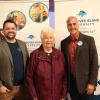December 19, 2006 - 4:00pm
Malaspina University-College’s newest Canada Research Chair won’t be just another name on a scientific report for some local Vancouver Island communities.
That’s because Dr. Grant Murray, Malaspina’s new Canada Research Chair in Coastal Resource Management, will be spending a lot of his research time over his five-year term talking with people who live in the coastal communities of Vancouver Island about environmental history and industrial impact.
“I’m going to take a look at specific areas to get a handle on what’s happening along the BC West Coast,” said Murray, who is involved in similar projects in Newfoundland and Mexico.
“Although environmental conflicts and issues can be very site specific, there are also a lot of common themes that can be applied to other areas.”
Murray, who started his new job at Malaspina Dec. 1, is an interdisciplinary social scientist, and takes both scientific data and social data into account.
By interviewing people about their knowledge of the environmental history of an area, he can gain a more complete picture of what has happened there, and help prepare for the future.
This information can be useful in developing ideas on how to better manage natural resources alongside industries like tourism and shellfish aquaculture.
As a scientist, Murray uses the scientific method. He takes a hypothesis and then tests it against data to prove if the idea is right or wrong. But unlike a natural scientist, Murray obtains his data from biological science and the human experience.
“People are not numbers, graphs or readouts but understanding the data they give you is still very important,” he said.
To digest the data he will gather from people, Murray will use a Geographical Information System. The mapping system will allow him to map out the environmental history a person has witnessed on the physical landscape. Then he can take the dozens of personal accounts and overlay them on top of one another to see the environmental trends.
“Oceans are increasingly being spatially managed and protected areas are on the rise so maps are a more important way to record and generate information from different user groups,” said Murray.
While research will be a large part of his job, so will teaching. Next fall Murray will begin teaching classes at Malaspina’s Nanaimo campus.
Students from many academic disciplines like biology, chemistry, recreational tourism, business and anthropology will benefit from his present and past projects.
By being multi-disciplinary, Murray hopes to bridge the gaps between different academic disciplines and show students how interconnected everything is. He also hopes to strengthen the ties between communities and the academic world of Malaspina.
Murray is one of 121 Canada Research Chairs the Government of Canada funded to work in educational institutions across the nation. The government invested $91.5 million in the project with $12.1 million of that coming from the Canada Foundation for Innovation (CFI). Of that CFI contribution, $74,000 was given to Malaspina to fund Murray’s research.
“Dr. Murray’s work will further develop Canada’s reputation as a place where outstanding research is being conducted,” said Dr. Eliot Phillipson, CFI President and CEO. “We can all be proud that Canada has become a place where world-class researchers want to be.”
Other CFI funded projects at Malaspina include the Applied Environmental Research Laboratories with Dr. Chris Gill and Dr. Erik Krogh, the Centre for Shellfish Research Nanaimo Lab with Dr. Bill Pennell and Don Tillapaugh, equipment and furnishings for the Centre for Shellfish Research Environmental Research Lab, the International Centre for Sturgeon Studies with Dr. John Morgan, which will be incorporated into the new Science building yet to be built, and the Centre for Coastal Health with Canada Research Chair Craig Stephen.
Tags: In the Community






